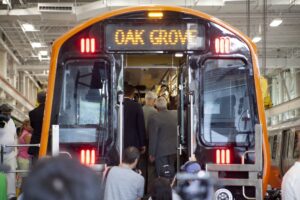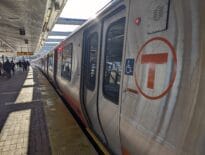With the MBTA planning to shut down its entire Orange Line subway to conduct a range of safety repairs and upgrades, the 101,000 people who take the line every day will need to use different ways to get to work.
What’s Happening
The unprecedented Orange Line shutdown starts at 9 p.m. Aug. 19 and lasts until 5 a.m. on Sept. 19. The planned work will replace five years’ worth of overnight and weekend closures and will address track issues flagged by federal safety inspectors.
“We’ve taken the time to listen to riders and sympathize with their frustrations. We’ve heard them loud and clear. They want bold action,” MBTA General Manager Steve Poftak said at a press conference Wednesday.
The T will post details online at MBTA.com/BBT2022.
Will It Be Done on Time?
With recent safety problems and the hangover from a decades-long maintenance backlog apparent every day, the T’s reputation with the public isn’t as strong as it once was. But Poftak assured reporters Wednesday that the repairs planned during the closure – which will involve both MBTA repair crews and private contractors – will be done on time. With many workers returning from summer vacations and both college and public school students returning to classrooms halfway through the shutdown, the pressure will be high to keep on schedule.
“We wouldn’t close down for 30 days unless we knew we had those contracts in place and we knew we had folks who would show up,” he said.
Gov. Charlie Baker told reporters the closure builds on successful but shorter and much more limited closures the T has undertaken in the past on parts of its network.
How Can People Get to Work?
Poftak, Baker and state Transportation Secretary Jamey Tesler repeatedly asked the public for their patience during Wednesday’s announcement, and laid out a series of options Orange Line riders can use to temporarily replace the subway line.
Commuter Rail
Commuter rail trains will pick up Orange Line riders at Forest Hills, Ruggles, Back Bay and South Station on the line’s southern portion, and at Oak Grove, Malden Center and North Station on the line’s northern portion. Anyone with a Charlie Card, paper Charlie Ticket or an MBTA monthly pass will be able to travel to zones 1A, 1 and 2 without buying a ticket on the train. Orange Line Riders going outbound should use Haverhill Line trains for travel to points north of downtown, and Needham and Providence line trains for points south.
Shuttle Buses
The MBTA will be providing a free shuttle service along the Orange Line route using between 160 and 200 contracted Yankee Line buses.
However, the exact route these buses will take, and whether or not they will get dedicated lanes for any or all of their journeys – a frequent criticism of past shuttle bus service by MBTA riders and advocates – is still up in the air. Poftak told reporters Wednesday that he was still talking with officials in the city of Boston and elsewhere to firm up what route the T would use and what interventions, like dedicated and enforced bus lanes, would be used to prevent the shuttle buses from getting stuck in traffic and getting over crowded. He promised to release more details soon.
Boston Mayor Michelle Wu told WBUR’s “Radio Boston” program last week that she would make sure the T’s shuttle bus services got “street space” if the T would go through with a project like this
Working from Home
Poftak also urged riders to work from home during the shutdown if they could. But the shutdown is also happening when city officials, commercial landlords and downtown businesses are all trying to lure workers back downtown.
Rick Dimino, CEO of business-backed advocacy group A Better City, called the plan “a surprise attack” on riders in an interview with Banker & Tradesman Wednesday morning.
“In theory the mayor has been engaged in the campaign to argue people should return to the office and return to Boston? This is cold water in the face of that idea,” he said.
Will the T Be Faster and Safer Afterwards?
That’s what Baker and Poftak are promising.
The shutdown will replace around 3,500 feet of track and eliminate slow zones across the Orange Line, including several flagged by Federal Transit Administration investigators near the Jackson Square, Back Bay, Tufts Medical Center and Haymarket stations. After a brief period following the shutdown where trains will be breaking in the new sections of track, Poftak said, journey times will be cut and the safety risks posed by the decades-old track will be eliminated. Signal upgrades and a deep cleaning of stations will also be part of the project.
“None of us should be satisfied until the system works the way we want it to,” Baker said Wednesday while defending his administration’s work to cut the MBTA’s $12 billion repair backlog by what he described as “about half” in the last eight years.
Baker also got backup from Boston Mayor Michelle Wu.
“Decades of deferred maintenance – compounded by a lack of urgency even in recent years – has left us at a crisis point for the MBTA and the hundreds of thousands of commuters who rely on public transportation every day,” BWu said in a statement. “A shutdown of this scale will be tremendously stressful for the region, but I’m hopeful that doing this necessary work now will save us years of disruption down the line.”
But advocacy group TransitMatters said in an extensive statement that the onus was on the T to prove the shutdown will be worth it.
“Riders have put up with years-long slow zones, teething problems with new vehicles, and diversions with no appreciable impact on service. The MBTA must clearly communicate the benefits of this shutdown to riders and unveil a line with better travel times, more reliable service, and improved rider experience,” the group said.
After the project is completed, Baker promised most of the trains running on the line will be brand-new. Only around half of the new Orange Line cars the MBTA has ordered from Chinese firm CRRC’s Springfield factory have been delivered so far, with the remainder being the same trains that have been in service on the line since the 1970s and 1980s, including one that prominently caught fire last month.
However, the T is currently running the Orange, Red and Blue lines on significantly reduced schedules due to a lack of staff in the lines’ control center, meaning far fewer trains than normal are needed to maintain service.
The T is training new dispatchers to take shifts that had previously been filled by having existing dispatchers work shifts as long as 20 hours, according to an FTA emergency safety order that banned the practice. However, it can only train six dispatchers at a time, a process that will likely last into next year, T officials said recently.
Dimino, of A Better City, has called for the T to bring in a temporary force of contractors and MBTA managers who are qualified to work as dispatchers until the new recruits are ready.
In a statement released after Wednesday’s press conference, Dimino said the T needed to add service on the commuter rail lines that run along the Orange Line corridor during the shutdown, prove that it has a robust customer service plan and show that it will ensure its shuttle buses operate with “bus rapid transit” functionality.
“Right now, this plan is insufficient and incomplete. While the work is necessary, due to the lack of planning and mitigation measures, its impact can be unnecessarily brutal for both riders and our region,” he said.
This story has been updated with comments from TransitMatters and A Better City.







